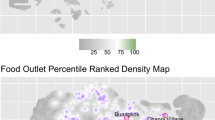Abstract
Although food deserts are areas that lack easy access to food outlets and considered a barrier to a healthy diet and a healthy weight among residents, food deserts typically comprise older urban areas which may have many parks and street configurations that could facilitate more physical activity. However, other conditions may limit the use of available facilities in these areas. This paper assesses the use of parks in two Pittsburgh food desert neighborhoods by using systematic observation. We found that while the local parks were accessible, they were largely underutilized. We surveyed local residents and found that only a minority considered the parks unsafe for use during the day, but a substantial proportion suffered from health limitations that interfered with physical activity. Residents also felt that parks lacked programming and other amenities that could potentially draw more park users. Parks programming and equipment in food desert areas should be addressed to account for local preferences and adjusted to meet the needs and limitations of local residents, especially seniors.
Similar content being viewed by others
References
Horowitz CR, Colson KA, Hebert PL, Lancaster K. Barriers to buying healthy foods for people with diabetes: evidence of environmental disparities. Am J Public Health. 2004; 94(9): 1549–54.
Roemmich JN, Epstein LH, Raja S, Yin L, Robinson J, Winiewicz D. Association of access to parks and recreational facilities with the physical activity of young children. Prev Med. 2006; 43(6): 437–41.
Gordon-Larsen P, Nelson MC, Page P, Popkin BM. Inequality in the built environment underlies key health disparities in physical activity and obesity. Pediatrics. 2006; 117(2): 417–24.
Ver Ploeg M, Breneman V, Dutko P, et al. Access to affordable and nutritious food: updated estimates of distance to supermarkets using 2010 data. http://www.ers.usda.gov/publications/err-economic-research-report/err143.aspx. 2011. Accessed 20 November 2011.
USDA. PART D: SCIENCE BASE section 3: Discretionary calories http://www.health.gov/DIETARYGUIDELINES/dga2005/report/HTML/D3_DiscCalories.htm. Accessed 17 Dec 2015.
Ogden CL, Carroll MD, Kit BK, Flegal KM. Prevalence of childhood and adult obesity in the United States, 2011–2012. JAMA. 2014; 311(8): 806–14.
TPL. 2015 city park facts. https://www.tpl.org/2015-city-park-facts. Accessed 17 Dec 2015.
Cohen DA, Han B, Derose KP, et al. Neighborhood poverty, park use, and park-based physical activity in a Southern California city. Soc Sci Med. 2012; 75(12): 2317–25.
Cohen DA, Lapham S, Evenson KR, et al. Use of neighbourhood parks: does socio-economic status matter? A four-city study. Public Health. 2013; 127(4): 325–32.
Cohen DA, McKenzie TL, Sehgal A, Williamson S, Golinelli D, Lurie N. Contribution of public parks to physical activity. Am J Public Health. 2007; 97(3): 509–14.
Weiss CC, Purciel M, Bader M, et al. Reconsidering access: park facilities and neighborhood disamenities in New York City. J Urban Health. 2011; 88(2): 297–310.
McKenzie TL, Cohen DA, Sehgal A, Williamson S, Golinelli D. System for Observing Parks and Recreation in Communities (SOPARC): reliability and feasibility measures. J Phys Act Health. 2006; 3(Suppl 1): S208–22.
Cohen DA (2015). The National Study of Neighborhood Parks: preliminary results. Greater and Greener Conference. San Francisco.
TPL. 2014 City park facts. http://www.tpl.org/2014-city-park-facts. Accessed 17 Dec 2015.
USCensus. American community survey. https://www.census.gov/programs-surveys/acs/. Accessed 17 Dec 2015.
Cohen DA, Marsh T, Williamson S, et al. Parks and physical activity: why are some parks used more than others? Prev Med. 2010; 50(Suppl 1): S9–12.
Acknowledgments
Research Support
This paper was supported in part by NHLBI # R01HL114432 and NCI # R01CA164137.
Author information
Authors and Affiliations
Corresponding author
Rights and permissions
About this article
Cite this article
Cohen, D., Hunter, G., Williamson, S. et al. Are Food Deserts Also Play Deserts?. J Urban Health 93, 235–243 (2016). https://doi.org/10.1007/s11524-015-0024-7
Published:
Issue Date:
DOI: https://doi.org/10.1007/s11524-015-0024-7




